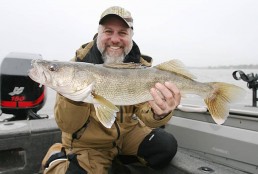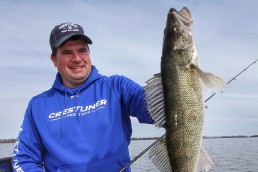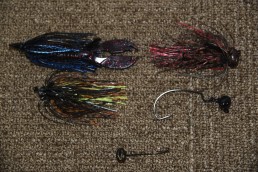Coldwater Bait Options for Walleyes
SHARE THIS POST
Walleyes love live bait. But when the water is cold and they are on the loose, lures will work just as well, or better, especially on the bigger fish.
Let’s take a look at four lure options that put more walleyes in the boat:
Blade baits
Thin metal wobblers like B-Fish-N Tackle B3 Blades and Wolf Tackle Big Dudes have been staples for river walleye anglers for decades—they cast like a rocket and sink like a rock. You would think this would spook a shallow walleye, but it attracts them. Blades are “reaction” baits and fish have a split second to react to something resembling fleeing baitfish, so they attack.
Never tie directly to a blade bait, as some makes will have several attach points or holes at the top (which give wider or tighter wobbles). It is best to use a snap or a split ring on top to prevent line cutting. Another trick to prevent snags in stumps, fallen timber or rock bottoms, is to cut the front barb of the front hook off to keep snags to a minimum.
A shallow-water trick I like to employ on blades or other bait is skipping. A sidearm cast low with a snap of your wrist will sometimes get the lure to skip along the surface, resembling fleeing bait. Couple that with fast-moving reaction bait.
A slow, steady retrieve of a blade is popular, but you should try it with a stop and go and high-speed retrieve. I also like to rip-jig the blade up with a fast rip of the rod followed by a slow reel to pull up the slack.
Crankbaits
Top walleye cranks are either minnow- or shad-shaped, but don’t be afraid to try a big fat bass model. Unlike blade baits, crankbaits should land softly, hardly making a splash. You’ll want to cast right up to the edge of the shore, since walleyes will sometimes get super-shallow, especially at night, which is prime time.
A longer 7- to 8-foot spinning rod spooled with 10-pound FireLine will definitely allow you to make a longer cast from boat or shore. A stop and go, fast and slow twitch and pause retrieve is great during the day, but a slow, steady retrieve is preferred at night. If you put too much action on the bait after dark, attacking walleyes may miss it.
Trolling cranks work great too. I’ll troll and cast Berkley Flicker Shads, Salmo Hornets and Cordell Wally Divers. These three have been staples for me for 25 years.
Are you enjoying this post?
You can be among the first to get the latest info on where to go, what to use and how to use it!
Ringworms and paddle tails
Longer length plastics have grown in popularity over the old faithful jig-n-twisters in the past dozen years. I’m sold on the B-Fish-N Tackle Moxi and Pulse-R; they have a lot of thump, vibration and attraction. The walleyes really slam them in April.
The retrieve is heavily influenced by the weight of your jig. A heavier weight allows you to drag or grind bottom and also work for rip-jiggin’ which is a rip of the rod, followed by a pause.
With a lighter jig, you can cast slightly upstream and let the worm tumble down in a controlled drift on a tight line. This is usually my preferred way of fishing ringworms. I’ll use just heavy enough of a jig to “tic” the bottom once and a while. Since there are different current speeds in different sections of a river, I’ll have three or four rods rigged with different colors and styles of ringworms on different weighted jigs. Then it is just a matter of refining the presentation of weight, color and style.
Bucktail jigs
Bucktail jigs are a secret of old-time river walleye anglers. They can be used with the local minnow of choice: fatheads, shiners or a river mix. You can add a Moxi or Pulse-R, or you can use them without any bait or dressing.
If I’m using bucktails without bait, I like to squirt a little Baitmate Gamefish or Live Walleye scent on the jig. The scent adheres to bucktail better than plastic and gives me more confidence. The way I like to look at it is that in cold water every little bit helps, and the addition of scent may just push that fat female walleye into striking.
Give these four baits a try this month for walleye fishing. If in a river, head up to the dam first and then work your way downstream until you find the hot spot. Start shallow on rock or gravel points, and try sand flats and reefs if you’re working a lake. Basically, any rock, gravel or sand transition area could potentially hold walleyes.
Walt Matan and his father Poppee are the chief lure designers for Custom Jigs & Spins. For more information on ice fishing and to see all of Custom Jigs & Spins tackle log on to customjigs.com or call 800-831-5535 for a free, all-new catalog. You can also log on to frabill.com to check out the Ice Hunter Series rod and reel combos and the Sentinel one-man tents.
MWO
SHARE THIS POST
Did you enjoy this post?
You can be among the first to get the latest info on where to go, what to use and how to use it!
Walt Matan
Walt Matan has been a writer and television host for MidWest Outdoors for 30 years. An avid ice and open-water fisherman, he currently lives in the Quad Cities on the shores of the Mississippi River. He is the product developer and brand manager for Custom Jigs & Spins, B-Fish-N Tackle, and Rippin Lips Catfish Tackle. For more information visit customjigs.com.



